Viruses ar - Study guides, Class notes & Summaries
Looking for the best study guides, study notes and summaries about Viruses ar? On this page you'll find 116 study documents about Viruses ar.
All 116 results
Sort by

-
BIO 353 Exam 1 Cell Biology 1. The three tenets of the cell theory are: A) 1. Organisms except viruses consist of one or more cells; 2. The cell is the basic unit of structure for all organism except viruses; 3. All cells arise only from existing cells
- Exam (elaborations) • 14 pages • 2024
-
- $12.99
- + learn more
BIO 353 Exam 1 Cell Biology 1. The three tenets of the cell theory are: A) 1. Organisms except viruses consist of one or more cells; 2. The cell is the basic unit of structure for all organism except viruses; 3. All cells arise only from existing cells
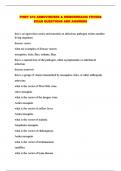
-
PHMY 610 ARBOVIRUSES & HEMORRHAGIC FEVERS EXAM QUESTIONS AND ANSWERS
- Exam (elaborations) • 7 pages • 2024
- Available in package deal
-
- $12.49
- + learn more
PHMY 610 ARBOVIRUSES & HEMORRHAGIC FEVERS EXAM QUESTIONS AND ANSWERS...
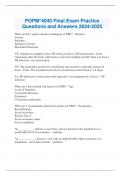
-
POPM*4040 Final Exam Practice Questions and Answers 2024-2025
- Exam (elaborations) • 22 pages • 2024
-
- $12.99
- + learn more
What are the 5 major causative pathogens of FBD? - Bacteria Viruses Parasites Biological Toxins Elements/Chemicals T/F: Organisms multiply in the GIT when you have a FB intoxication - False. Organisms enter the body with food or water and multiply in GIT when you have a FB infection - not intoxication. T/F: The incubation period for a food borne intoxication is typically around 24 hours - False. The incubation period for a food borne intoxication is < 4 hours. Is it FB infection ...
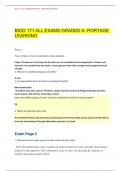
-
BIOD 171 ALL EXAMS GRADED A –PORTAGE LEARNING Exam 1. True or False:A virus is considered a microorganism. False. Viruses are not living and as such are not considered microorganisms. Viruses can, however, be classified as microbes, a more general term t
- Exam (elaborations) • 35 pages • 2024
-
- $10.49
- + learn more
BIOD 171 ALL EXAMS GRADED A –PORTAGE LEARNING Exam 1. True or False:A virus is considered a microorganism. False. Viruses are not living and as such are not considered microorganisms. Viruses can, however, be classified as microbes, a more general term that includes microorganisms and viruses. 2. What is the smallest biological unit of life? A cell. 3. At a generalized level, all cells are comprised of what? Macromolecules* *A student may also answer: Proteins, Lipids, Nucleic acid...
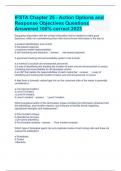
-
IFSTA Chapter 25 - Action Options and Response Objectives Questions Answered 100% correct 2023
- Exam (elaborations) • 13 pages • 2023
- Available in package deal
-
- $22.49
- 1x sold
- + learn more
IFSTA Chapter 25 - Action Options and Response Objectives Questions Answered 100% correct 2023 Equipping responders with the critical information that is needed to make good decisions, while not overwhelming them with nice-to-know information is the key to: ct identification and control. -based response. nse model implementation. monitoring and detection. risk-based response. A personnel tracking and accountability system must include: a.a method to exclude all nonesse...

-
BIOD 171 M1: Module 1 Exam - Requires Respondus LockDown Browser + Webcam True/False. A virus is classified as a microbe. True Although viruses are not living and as such are not considered microorganisms, they can, however, be classified as microbes, a m
- Exam (elaborations) • 10 pages • 2023
-
- $17.99
- + learn more
BIOD 171 M1: Module 1 Exam - Requires Respondus LockDown Browser + Webcam True/False. A virus is classified as a microbe. True Although viruses are not living and as such are not considered microorganisms, they can, however, be classified as microbes, a more general term that includes microorganisms and viruses. False True or False: The smallest biological unit of life is the molecule. True False The smallest biological unit of life is the cell. What are the four main types of macromol...
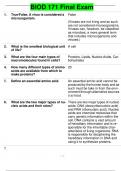
-
1 / 32 BIOD 171 Final Exam
- Exam (elaborations) • 32 pages • 2024
-
- $12.49
- + learn more
1 / 32 BIOD 171 Final Exam 1. True/False. A virus is considered a microorganism. 2. What is the smallest biological unit of life? 3. What are the four main types of macromolecules found in cells? 4. How many different types of amino acids are available from which to make proteins? False (Viruses are not living and as such are not considered microorganisms. Viruses can, however, be classified as microbes, a more general term that includes microorganisms and viruses.) A cell Pro...

-
Microbiology Exam 1 Questions with 100% Correct Answers | Verified | Updated
- Exam (elaborations) • 17 pages • 2024
- Available in package deal
-
- $13.49
- + learn more
Microbiology Exam 1 Questions with 100% Correct Answers | Verified | Updated Microorganism - answerare organisms that are too small to see with the unaided eye examples of microorganisms - answerbacteria fungi protozoa microscopic algae viruses what kind of microscope do you use when you are working with microorganisms you can't see? - answerbright field microscope what are the different magnifications of a bright field microscope - answer4x 10x 40x 100x what is the kind of micros...
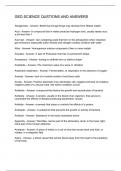
-
GED SCIENCE QUSTIONS AND ANSWERS
- Other • 20 pages • 2023
- Available in package deal
-
- $12.49
- + learn more
Abiogenesis - Answer- Belief that livings things may develop from lifeless matter Acid - Answer- A compound that In water produces hydrogen ions, usually tastes sour, a pH less than 7 Acid rain - Answer- rain containing acids that form in the atmosphere when industrial gas emissions (especially sulfur dioxide and nitrogen oxides) combine with water Alloy - Answer- Homogenous mixture composed of two or more metals Amoeba - Answer- A type of Protozoan that has no permanent shape Amo...
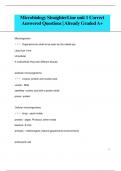
-
Microbiology StraighterLine unit 1 Correct Answered Questions| Already Graded A+
- Exam (elaborations) • 15 pages • 2024
- Available in package deal
-
- $12.19
- + learn more
Microorganism : Organisms too small to be seen by the naked eye Less than 1mm Unicellular If multicellular thay lack different tissues acellular microorganisms : viruses -protein and nucleic acid, viroids - RNA satellites -nucleic acid with a protein shell prions- protein Cellular microorganisms : fungi - yeast molds protists - algae, Protozoa, slime molds bacteria -E Coli archaea - methanogens (natural gas)extreme environments prokaryotic cell 2 : cell that does not have a nuc...

How did he do that? By selling his study resources on Stuvia. Try it yourself! Discover all about earning on Stuvia


